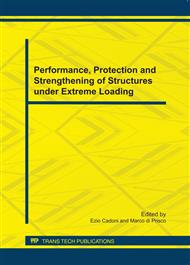p.740
p.746
p.752
p.758
p.764
p.770
p.778
p.784
p.790
On the Fire Scenario in Road Tunnels: A Comparison between Zone and Field Models
Abstract:
Some catastrophic fires occurred in the last 15 years in both road and railway tunnels usedby millions of people are turning the attention of the engineering community towards the assessmentof the structural safety of tunnels, both during and after a fire. To this end, a realistic description offire propagation and a reliable picture of the thermal field are mandatory, in order to evaluate thethermal load acting on the lining and the partitions. With reference to a rather common road-tunnelgeometry, three possible thermal inputs representing as many levels of fire severity are consideredhere, namely the burning of a car, of a bus and of a heavy-goods vehicle (HGV). The fire scenariois firstly modeled by means of a rather simple but handy code based on a two-zone model for thedescription of the fire in each compartment. Later, a more complex code based on computational fluiddynamics applied to the simulation of fire development (Fire Dynamics Simulator - FDS) is used toallow a comparison between the numerical results obtained in either way, and to check to what extentsome available experimental results concerning similar tunnels can be fitted. The fitting shows that- by properly subdividing the tunnel (that has no compartments) into a suitable number of “virtual”compartments - the agreement between the two codes is very good, as well as that between numericaland experimental results.
Info:
Periodical:
Pages:
764-769
Citation:
Online since:
July 2011
Keywords:
Price:
Сopyright:
© 2011 Trans Tech Publications Ltd. All Rights Reserved
Share:
Citation:


